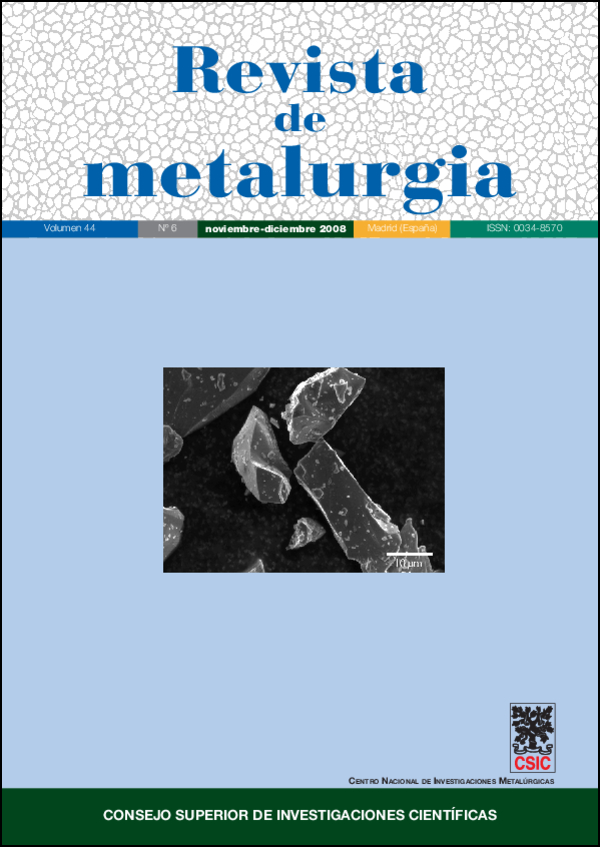Flat friction tests applied to austenic stainless steels with several surface finish. Analysis of adhesion conditions in friction
DOI:
https://doi.org/10.3989/revmetalm.0773Keywords:
Flat faced friction, Austenitic stainless steels, Boundary lubricationAbstract
The main purpose of this work is to evaluate the tribological behaviour of austenic stainless steels AISI 304 with bright annealed surface finishing (BA) (ASTM a 240); AISI 304 DDQ and AISI 316 with bright surface finishing (B). The assays have been carried out in flat faced dies system with mineral oil of 200 cts viscosity, S2Mo grease and in dry conditions.. The relationship between friction coefficient and pressure and velocity has been established for the mineral oil as lubricant. In these conditions, a strong adhesive tendency has been found in boundary lubrication regime. The results obtained here, show us that S2Mo grease leads to lowest values for the friction coefficient. A minor adhesive behaviour tendency for AISI 316 steel, harder than 304 grades, has been found. A relevant plowing phenomena has been observed for the more critical friction conditions tried out. A surface hardener is produced as a consequence of that.
Downloads
References
[1] J.L. Andreasen, N. Bay, M. Andersen, E. Christensen y N. Bjerrum, Wear 207 (1997) 1-5. doi:10.1016/S0043-1648(96)07462-5
[2] J.L. Andreasen, N. Bay y L. De Chiffre, Int. J. Mat. Tools Manufact. 38 (1998) 503-510. doi:10.1016/S0890-6955(97)00095-3
[3] D.D. Olsson, N. Bay y J.L. Andreasen, CIRP Ann. Manuf. Technol. 53 (2004) 231-234. doi:10.1016/S0007-8506(07)60686-6
[4] E. Van der Heide, Wear 254 (2003) 1.127-1.133.
[5] E. Sheadin, Proc. Conf. Applications on Stainless Steel, Jernkontoret, Stockholm, Suecia, 1992, pp.137-46.
[6] M.P.F. Sutcliffe, H.R. Le y D. Farrugia, Wear 254 (2003) 523-531. doi:10.1016/S0043-1648(02)00295-8
[7] Z. Wang, K. Dohda y Y. Haruyama, Wear 260 (2006) 249-257. doi:10.1016/j.wear.2005.04.029
[8] G. Bregiozzi, A. Schino, J.M, Kenny y H, Haefke, Mater. Lett. 57 (2003) 4.505-4.508.
[9] A. Määttä, P. Vuoristo y T. Mäntylä, Tribol. Int. 34 (2001) 779-786. doi:10.1016/S0301-679X(01)00074-3
[10] E. Iizuka, C. Fuginaga, T. Hira, M. Morita y O. Furukimi, IDDRG Biennal Congress 17th, Shenyang, China, 1992, pp. 239-247.
[11] C. Ferrer, J.J. Saura, K.A. Razzaq, A. Carcel, G. Esteller y M.A. Pérez-Puig, II Congreso Ibérico de Tribología TRIB 2003, Valencia, España, Ed. UPV, 2003, pp. 49-56.
[12] V. Miguel, C. Ferrer, A. Calatayud, A. Martínez y J. Coello, II Congreso Ibérico de Tribología TRIB 2003, Valencia, España, Ed. UPV, 2003, pp. 1-6.
[13] J. Coello, V. Miguel, C. Ferrer, A. Calatayud y A. Martínez, International Deep-drawing Research Group, IDDRG 2007 Int. Conf., Györ, Hungría, 2007, Mikós Tisza (Ed.), University Publisher in Miskolc, 2007, pp. 139-146.
[14] G. Di Caprio, Los aceros inoxidables, Ed. Grupinox, Barcelona, España (1999) pp. 225-229.
[15] J. Coello, V. Miguel, A. Calatayud, A. Martínez y C. Ferrer, IV Congreso Ibérico de Tribología, Bilbao, España, 2007, pp. 1-8.
[16] F. P. Borden y D. Tabor, The friction and lubrication of solids, Ed. Oxford Classics Series, EE.UU., 2001, pp. 90-115.
[17] M. A. Martínez, J. Ordieres, J. Botella, R. Sánchez y R. Parra, Rev. Metal. Madrid Vol. Extr. (2005) 64-68.
[18] ASM Handbook 18 Friction, Lubrication and Wear Technology, 3rd ed., ASM International, EE.UU., 1998, pp. 27-39.
[19] A. Wihlborg y L. Gunnarson, IDDRG Biennal Congress 17th, Shenyang, China, 1992, pp. 281-289.
Downloads
Published
How to Cite
Issue
Section
License
Copyright (c) 2008 Consejo Superior de Investigaciones Científicas (CSIC)

This work is licensed under a Creative Commons Attribution 4.0 International License.
© CSIC. Manuscripts published in both the printed and online versions of this Journal are the property of Consejo Superior de Investigaciones Científicas, and quoting this source is a requirement for any partial or full reproduction.
All contents of this electronic edition, except where otherwise noted, are distributed under a “Creative Commons Attribution 4.0 International” (CC BY 4.0) License. You may read the basic information and the legal text of the license. The indication of the CC BY 4.0 License must be expressly stated in this way when necessary.
Self-archiving in repositories, personal webpages or similar, of any version other than the published by the Editor, is not allowed.
















